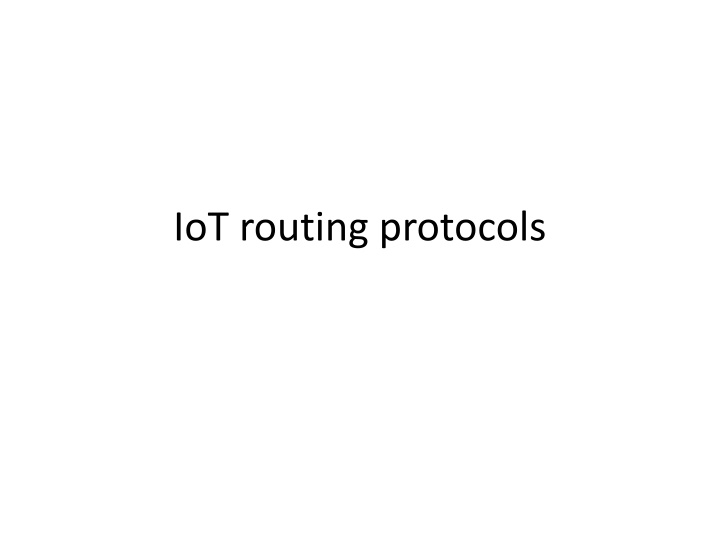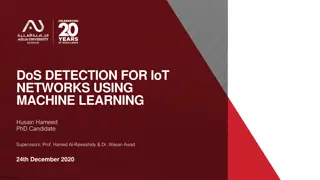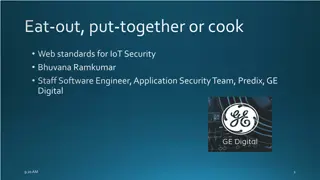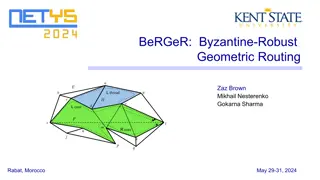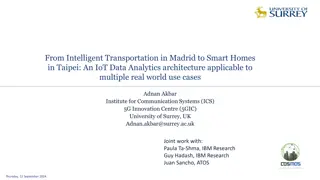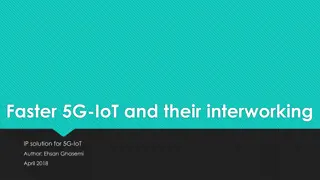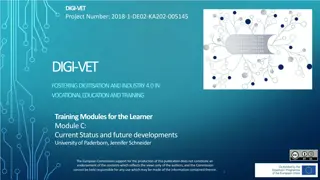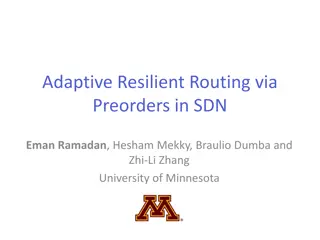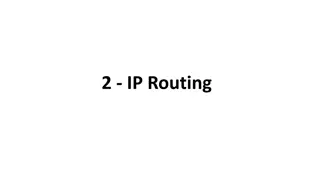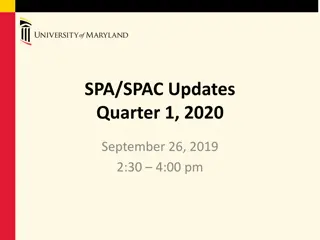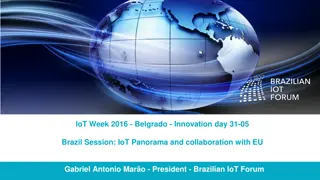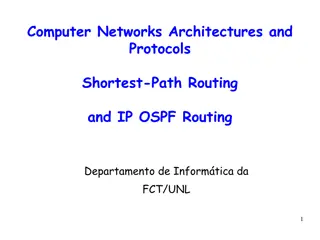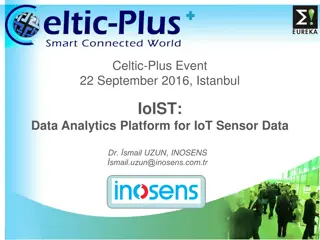Overview of IoT Routing Protocols and Taxonomies
Delve into various IoT routing protocols like flat-based, hierarchical-based, location-based, negotiation-based, and more, alongside detailed insights on taxonomies and routing metrics used in IoT networks. Learn about different routing strategies and path examples for optimizing network performance.
Download Presentation

Please find below an Image/Link to download the presentation.
The content on the website is provided AS IS for your information and personal use only. It may not be sold, licensed, or shared on other websites without obtaining consent from the author.If you encounter any issues during the download, it is possible that the publisher has removed the file from their server.
You are allowed to download the files provided on this website for personal or commercial use, subject to the condition that they are used lawfully. All files are the property of their respective owners.
The content on the website is provided AS IS for your information and personal use only. It may not be sold, licensed, or shared on other websites without obtaining consent from the author.
E N D
Presentation Transcript
Taxonomies in detail (1/3) Flat-based routing protocols consider all nodes of equal functionality or role. in hierarchical-based routing protocols, different nodes may assume different roles in the routing process, that is, some nodes may forward data on behalf of others, while other nodes only generate and propagate their own sensor data. Location-based routing protocols rely on the location information from nodes to make routing decisions.
Taxonomies in detail (2/3) Routing protocols are responsible for identifying or discovering routes from a source or sender to the intended receiver. Reactive protocols discover routes on-demand, that is, whenever a source wants to send data to a receiver and does not already have a route established. Proactive (table driven) routing protocols establish routes before they are actually needed.
Taxonomies in detail (3/3) Negotiation-based protocols aim to reduce redundant data transmissions by relying on the exchange of negotiation messages between neighboring sensor nodes before actual data transfers occur. Multipath-based protocols use multiple routes simultaneously to achieve higher performance or fault tolerance. Query-based routing protocols are receiver-initiated, that is, sensor nodes send data in response to queries issued by the destination node. The goal of QoS-based routing protocols is to satisfy a certain Quality of- Service (QoS) metric (or a combination of multiple metrics), such as low latency, low energy consumption, or low packet loss. Coherent-based protocols perform only a minimum amount of processing (e.g., eliminating duplicates, time-stamping) before sensor data is sent to receivers and data aggregators. In non-coherent protocols, nodes may perform significant local processing of the raw data before it is sent to other nodes for further processing.
Routing metrics Minimum Hop Minimum energy consumed per packet Maximum time to network partition Minimum variance in node power levels Maximum (average) energy capacity Maximum minimum energy capacity
Path examples for different metrics Min energy per packet: A D G Min hop: B-G Max energy capacity: C E G Maximum minimum energy capacity: B-G
Flooding A simple strategy to disseminate information into a network or to reach a node at an unknown location is to flood the entire network. A sender node broadcasts packets to its immediate neighbors, which will repeat this process by rebroadcasting the packets to their own neighbors until all nodes have received the packets or the packets have traveled for a maximum number of hops. Flooding problems: Implosion - A node receiving a packet relays this packet to all its neighbors using bcasting, regardless of whether these neighbors have already received this packet from other neighbors. Overlap: Sensors are often used to monitor overlapping geographic areas Resource Blindness: The simplicity of flooding also means that flooding is incognizant of the resource constraints of individual nodes.
Gossiping A variation of flooding is gossiping, where a node does not necessarily bcast data. Instead, it uses a probabilistic approach, where it decides to forward the data to its own neighbors with a probability p and to discard the data with a probability 1-p.
Sensor Protocols for Information via Negotiation (SPIN) SPIN is a family of negotiation-based, data-centric, and time-driven flooding protocols. However, compared to classic flooding, SPIN nodes rely on two key techniques to overcome the deficiencies of flooding. To address the problems of implosion and overlap, SPIN nodes negotiate with their neighbors before they transmit data, allowing them to avoid unnecessary communications. To address the problem of resource blindness, each SPIN node uses a resource manager to keep track of actual resource consumption, allowing them to adapt routing and communication behavior based on resource availability.
SPIN (cont.) Data is flooded via a 3-way handshake protocol. First, when new data arrives, a node advertises this event using an advertisement message (ADV) to its neighbors via the data s meta-data. Upon receiving an advertisement, a node checks whether it has already received the described data. If not, the node responds with a request for data (REQ) message, indicating its desire to receive the advertised data. Finally, the sender node responds to the REQ message with a DATA message, containing the advertised data.
Proactive Routing / DSDV The Destination-Sequenced Distance Vector routing protocol is a modified version of the classic Distributed Bellman-Ford algorithm. In distance-vector algorithms, every node i maintains a list of distances {dxij} for each destination x via each neighbor j. Then, node i selects node k as the next hop for packet forwarding if dxik = min{dxij}. This information is stored in a routing table, along with a sequence number for each entry, where this number is assigned by the destination node. The purpose of the sequence numbers is to allow nodes to distinguish stale routes from new ones in order to prevent routing loops. Each node broadcasts updates to the routing table periodically, but also immediately whenever significant new information becomes available. DSDV uses two types of packets to share its routing table content. A full dump contains all available routing information, whereas an incremental packet contains only information that has changed since the last full dump. Incremental packets are typically much smaller than full dumps, therefore reducing the control overhead of DSDV. When a node receives an incremental packet, the received information is compared with the node s current knowledge and a route indicated in the packet replaces the corresponding route in the node s table if the packet s route has a more recent sequence number. A packet s route also replaces the node s route in its table if the sequence numbers are identical, but the packet s route has a shorter distance
Location Based Routing Location-based or geographic routing can be used in networks where sensor nodes are able to determine their position using a variety of localization systems and algorithms. Sensors use geographic information to make forwarding decisions. In unicast location-based routing, packets are sent directly to a single destination, which is identified by its location. That is, a sender must be aware not only of its own location, but also the location of the destination. This location can be obtained either via querying (e.g., flooding a query to request a response from the destination containing its location) or a location broker, that is, a service that maps node identities to locations. In broadcast or multicast location-based routing approaches, the same packet must be disseminated to multiple destinations. Multicast protocols take advantage of the known destination locations to minimize resource consumption by reducing redundant links. The identity of a sensor node is typically less important than its location, that is, data may be disseminated to all nodes that lie within a certain geographic region. This approach is called geocasting and can, for example, be used to diffuse queries to specific regions of interest instead of flooding the entire network, significantly reducing both bandwidth and energy requirements. Once a packet reaches the desired region, it must be either disseminated (multicast) to all nodes within this region or transmitted to at least one node within this region (anycast). Typically, location-based routing protocols require that every node in the network knows its own geographic location and the identities and locations of its one-hop neighbors (e.g., obtained via periodic beacon messages).
Unicast Location-Based Routing In unicast location-based routing, the goal is to propagate a packet to a specific node located at a position known to the sender. The routing protocol s responsibility on each node is to make a local forwarding decision to ensure that a packet moves closer to the destination with each hop. In this greedy forwarding approach, it is only required that each node knows its own location and the location of its neighbors, and the source must know the location of the destination.
Forwarding strategies Greedy: This technique chooses a neighbor that minimizes the distance to the destination in each hop. (node E). The goal of the greedy approach is to minimize the number of hops required to reach the destination. Nearest with Forwarding Progress (NFP): This strategy chooses the nearest neighbor of all neighbors that make a positive progress (in terms of geographic distance to the destination) toward the destination. Sensor nodes that can adapt their transmission powers can choose the smallest transmission power necessary to reach this neighbor (node A), thereby contributing to reduced packet collisions in their neighborhood. Most Forwarding Progress within Radius (MFR): MFR selects the neighbor that makes the greatest positive progress towards the destination, where progress is defined as the distance between the source and its neighbor node projected onto a line drawn from the source to the destination (node B). This technique attempts to minimize the number of hops a packet must travel. Compass Routing: This strategy chooses the neighbor with the smallest angle between a line drawn from the source to the neighbor and the line connecting the source and the destination. This approach (node C) attempts to minimize the spatial distance that a packet has to travel.
Greedy Perimeter Stateless Routing A routing protocol that makes forwarding decisions based on the positions of nodes and a packet s destination is Greedy Perimeter Stateless Routing (GPSR). GPRS nodes only require information about their immediate neighbors to decide where to relay a packet. The source of a packet marks the packet with the location of the destination node. If a node knows all its neighbors positions (e.g., obtained via periodic HELLO or beacon messages), an intermediate node can make a locally optimal forwarding decision by selecting the neighbor that is geographically closest to the destination. Continuing this process node by node, the packet will move closer and closer to the destination with every hop, until the destination is reached.
Perimeter Routing Since every intermediate node makes a forwarding decision based only on its knowledge of its neighbors locations, it can happen that a packet must move temporarily farther in geometric distance from the destination to ultimately continue its path toward the destination. See figure: Node x is closer to the destination than both its neighbors y and w. Here, the dashed arc around the destination has a radius equal to the distance between the destination and x. Based on the greedy forwarding protocol, x would not select any of the two paths that would lead to the destination.
